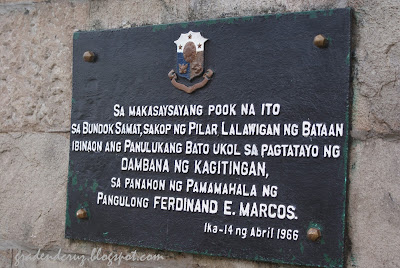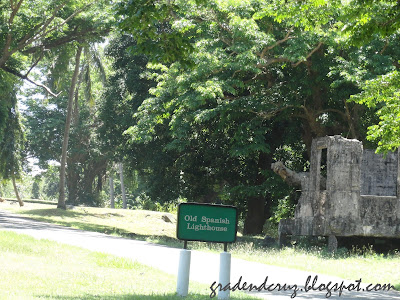It was an early morning wake-up call that signaled us to better get ready and catch the ferry boat going to Corregidor Island by around 7:00 am. Contrary to what I have known, Corregidor is a part of Cavite and not Bataan. Excited? Yes, because this is another first on my list of new experiences. I have heard about it, learned about a bit of its history in the classroom, but to really dwell on what has transpired during the World War II and the Japanese occupation was not my cup of tea. My personal historian, Dennis, has ignited the interest and the desire in me to learn more about history.... Philippine history, American history or even World history, for that matter. It's the manner of his delivery and the depth of his knowledge which showed conciseness and precision that has amazed me in so many ways. During one of our regular conversations, he asked me to inquire about the trip to Corregidor Island. He has researched about it and he wanted us to visit this place and have the feel of what was left after the war. The truth is, we have booked this trip for months prior to his scheduled vacation here in the Philippines.
We were on board the ferry and seeing a lot of tourists (locals and foreign nationals) with us was an indicator that there are still a lot who care to learn more about our history. It was a 45 minutes boat trip going to the island. Our trip was scheduled on April 9 which was commemorative of the Fall of Bataan, a national holiday. Over lunch, we had the chance to talk to an old American who shared his experiences as a young soldier during the Japanese occupation.
We were ushered in to the Corregidor Inn because we opted for the overnight accommodation so as to fully appreciate and enjoy what the island can offer. Our trip was a guided tour trip which has in it a line-up of activities.
 |
| The Corregidor Inn |
Historically, Corregidor's significance dates back in the 1500s because of it's strategic location. Corregidor is a Spanish term which means corregir — “to correct”. A marker reads in part: “Corregidor Island became a part of the Spanish Crown on May the 19th 1571 after its occupation by the dauntless Miguel Lopez de Legaspi, who found the City of Manila. Due to its strategic position, Corregidor, which was a Spanish island for 327 years until May 2, 1898, served as a fortress, guarding Manila Bay.” The Spanish lighthouse and the marker nearby, as well as the flagpole taken from a Spanish warship, are witnesses to the fact that before Spain ceded the Philippines to the United States in 1898, after the Spanish-American War, Corregidor Island used to be a checkpoint for vessels entering Manila Bay. (corregidor-island-history-in-the-ruins)
 |
| The Tour Guide |
 |
The Spanish Lighthouse,
one of the oldest landmarks first lit in 1853
|
Corregidor has been designated into three parts — the Bottomside, the Middleside and the Topside. Nothing was left but the ruins....remnants of a war that remain significantly a reminder of our historical past.
 |
| The Hospital |
We were led to the Battery Way and the other batteries that I can not recall. I was confused because when we reached the place where we were led, all I saw were big canons and artilleries. So I said, hmmmm.....maybe this is how they call it in military parlance. On the other hand, I tried to imagine how painstakingly it took them to assemble each of these heavy metals. Even the screws were as big as one can even imagine.
We were also brought to the Malinta Tunnel. Dennis told me that it was called "malinta" meaning leech because at that time there were a lot of leeches. We witnessed the "Malinta Tunnel Lights and Sounds" show which was written and directed by Lamberto Avellana as his final tribute to valor and peace.
 |
| The Malinta Tunnel |
We also saw the Pacific War Memorial marker in honor of the World War II heroes. It also has a structure that has a circular altar directly located under the dome's open center allowing light to fall directly on it on daylight. There is also a museum that houses memorabilias about its history.
At the far end of the Pacific War Memorial is the "Monument of the Eternal Flame" which is a dynamic steel sculpture that signifies the beacon of light of hope, courage and freedom for the heroes of the World War II.
The Lorcha Dock near the MacArthur's Park is the dock where General Douglas MacArthur departed going to Australia.
There are a lot to see in Corregidor Island. It is a whole package of learning, adventure, and fun. Our daughter also had the chance to experience the zip line. An experience of going in the Japanese tunnels was also one of the highlights of our trip.
We were able to watch the sun set and sun rise without any hindrances of
skyscrapers or anything that would block us from appreciating this
natural beauty. This has completed the package of our trip as we were able to witness how the majestic sun rises in the east and sets in the west. Truly, man's wit and intellect will never equate God's omnipotence and omniscience.
 |
| Sunset |
 |
| The Sunrise |
Related Links:
http://corregidor.org/ct&n_index.html
http://corregidorisland.com/history.html
http://corregidor.org/chs_trident/trident_02.htm
http://expatphilippines.ph/?p=1564
http://visitpinas.com/corregidor-island-history-in-the-ruins/
http://voices.yahoo.com/the-history-corregidor-island-philippines-576422.html
http://militaryhistory.about.com/od/worldwarii/p/World-War-Ii-Battle-Of-Corregidor.html
http://ww2panorama.org/panoramas/corregidor


























































